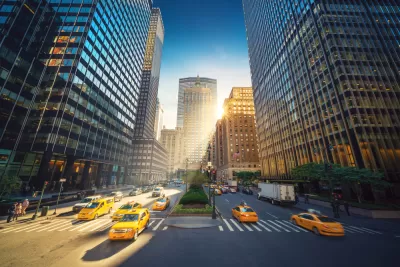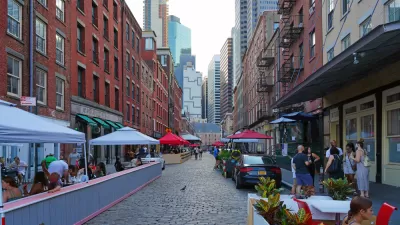The debate about whether the pedestrian-oriented changes made to the New York City streetscape during the pandemic should be permanent has a high-profile battleground on Park Avenue.

John Surico writes about a planning opportunity that could restore the median of Park Avenue in Manhattan to its former prominence as a pedestrian promenade.
"It has been a long time, but once it was possible and even fashionable to take a stroll through a far different Park Avenue, one with a green swath of lush lawn and shrubbery nearly 40 feet wide. It was the city’s first linear park, where pedestrians took precedence over cars and there were plenty of benches to take a break," according to Surico.
A project to repair an underground, "cavernous" shed used by Metro-North commuter trains traveling in and out of Grand Central Station also offers an opportunity to "transform Park Avenue’s malls and restore them to their original splendor," reports Surico.
"The work requires ripping up nearly a dozen streets along Park Avenue, from East 46th to East 57th Streets, making possible a new vision for that stretch of the thoroughfare."
"Among the options the city is considering is bringing back chairs and benches, along with more ambitious ideas like expanding the median, eliminating traffic lanes and carving out room for bike lanes and walking paths."
The Park Avenue project is just one example of an ongoing, citywide debate about whether the pandemic offered a chance to permanently rethink the city's streets, providing more space for pedestrians and people on bikes instead of more and more cars. As with other examples around the city, "the removal of traffic lanes along Park Avenue is likely to elicit backlash from drivers who complain that the addition of pedestrian plazas and bike lanes across the city has made it increasingly difficult to get around," writes Surico. The city has already retreated from some of the open streets and bus priority plans crafted during the pandemic.
FULL STORY: New York City Wants to Bring More Park to Park Avenue

Maui's Vacation Rental Debate Turns Ugly
Verbal attacks, misinformation campaigns and fistfights plague a high-stakes debate to convert thousands of vacation rentals into long-term housing.

Planetizen Federal Action Tracker
A weekly monitor of how Trump’s orders and actions are impacting planners and planning in America.

In Urban Planning, AI Prompting Could be the New Design Thinking
Creativity has long been key to great urban design. What if we see AI as our new creative partner?

Milwaukee Launches Vision Zero Plan
Seven years after the city signed its Complete Streets Policy, the city is doubling down on its efforts to eliminate traffic deaths.

Portland Raises Parking Fees to Pay for Street Maintenance
The city is struggling to bridge a massive budget gap at the Bureau of Transportation, which largely depleted its reserves during the Civd-19 pandemic.

Spokane Mayor Introduces Housing Reforms Package
Mayor Lisa Brown’s proposals include deferring or waiving some development fees to encourage more affordable housing development.
Urban Design for Planners 1: Software Tools
This six-course series explores essential urban design concepts using open source software and equips planners with the tools they need to participate fully in the urban design process.
Planning for Universal Design
Learn the tools for implementing Universal Design in planning regulations.
Gallatin County Department of Planning & Community Development
Heyer Gruel & Associates PA
JM Goldson LLC
City of Camden Redevelopment Agency
City of Astoria
Transportation Research & Education Center (TREC) at Portland State University
Jefferson Parish Government
Camden Redevelopment Agency
City of Claremont





























